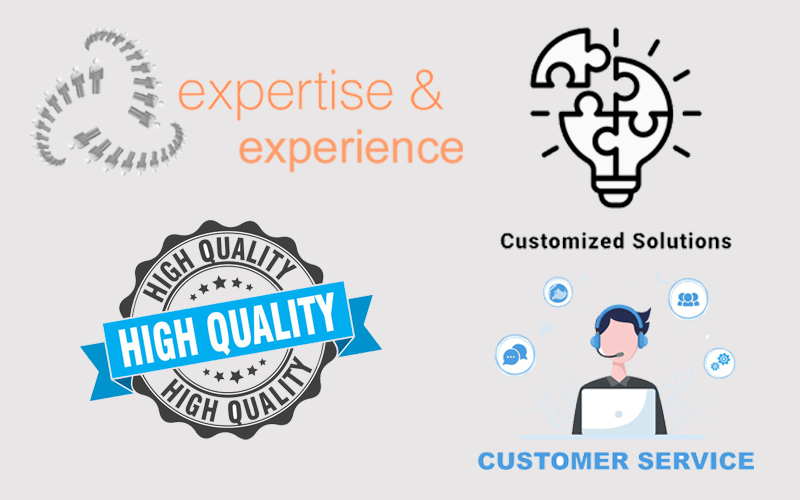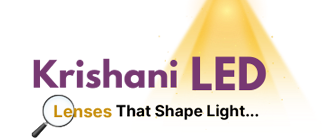- Home
- Most Suitable Material For Led Lens
Most Suitable Material for Your LED Lens Project
When manufacturing efficient, high-performance lighting systems, the choice of material most suitable material for your LED lens project is fundamental. Not only does the best material enhance the emission and direction of light, but it also offers longevity and operational performance across various conditions. At Krishani, we understand that every LED application, whether industrial, commercial, automotive, or architectural, has its unique requirements. That is why we primarily focus on materials that provide optimum light transmission efficiency, UV stability, chemical resistance, etc. This guide discusses the key considerations to make when choosing your LED lens materials and how each affects performance, price, and lifespan.
Importance of Material Choice in LED Lens Development
The material for a lens determines everything from the light transmission efficiency and refractive index to thermal insulation and environmental durability. Whether you're designing floodlight lenses, streetlight lenses, or stadium light lenses, the material needs to support the performance needs as well as sustain the actual conditions of application. The ideal material provides the optimal optical performance as well as value for money and durability.
Key Factors for Choosing LED Lens Materials When choosing materials for LED lenses, it is necessary to consider several key factors. Let's discuss each in turn:
1. Light Transmission Efficiency The capability of a material to transmit light with negligible loss is vital for LED lenses. Materials with the highest light transmission efficiency give maximum brightness and efficiency of energy. PMMA (Acrylic) and polycarbonate optical-grade are most well recognized by high transmission values (often 85% to 93%).
2. Refractive Index The refractive index determines the amount of light deflected by the material. Higher refractive materials have the ability to accommodate tighter beam angles and more precise optics. This is especially beneficial in applications like task lighting or spotlighting, where beam focus is essential.
3. Thermal Resistance (-40°C–200°C) Thermally resistant materials should be able to maintain structural and optical integrity in adverse environments. Therefore, LED lenses should withstand high thermal resistance, ideally between -40°C and 200°C, without deformation, discoloration, or degradation. Silicone and certain polymers can withstand this range without any issues.
4. UV Stability Yellowing or brittleness can be caused by exposure to UV light, especially in the case of high-intensity or outdoor applications. UV stability is very important to ensure the lens stays clear and doesn't warp too soon. These products are made with materials such as silicone and UV-stabilized polycarbonate.
5. Chemical Resistance In industrial or automotive applications, LED lenses come into contact with oils, solvents, and cleaning solutions. PMMA and silicone are good materials to use since they provide excellent chemical resistance, which avoids corrosion and provides a longer lifespan.
6. Flexibility Flexibility is important for custom lens designs because some applications, like bendable LED strips, require materials that can be bent into various shapes without breaking. Silicone, with its soft but tough structure, is a material of choice for highly flexible lens elements.
7. Environmental Durability Environmental durability provides long-term optical performance and structural integrity, minimizing maintenance and replacement expenses. Silicone is superior to other materials in resisting moisture, dust, and temperature changes to provide environmental resistance in industrial or outdoor applications.
8. Cost-Effectiveness Maintaining performance in context while monitoring cost is most important. Glass is highly resistant and clear, but more costly and brittle than polymers like polycarbonate or PMMA, which offer long-term cost effectiveness through longer life and lower maintenance costs.
Material Comparison Let's take a closer look at the materials typically used for LED lenses and compare them:
|
Material |
Advantages |
Disadvantages |
Applications |
|
PMMA |
High light transmission (>92%), lightweight, cost-effective |
Lower impact resistance and thermal stability compared to PC |
Indoor lighting, decorative applications |
|
Polycarbonate (PC) |
High impact resistance, thermal resistance (-40°C–200°C), flame-retardant |
Prone to UV yellowing without protective coatings |
Automotive lighting, industrial applications |
|
Silicone |
Excellent UV stability, high flexibility, superior environmental durability |
Higher initial cost compared to PMMA and PC |
Outdoor lighting, automotive headlamps |
|
Glass |
Exceptional optical clarity, high-temperature resistance |
Heavyweight, prone to breakage |
High-end architectural lighting |
Customization & Application-Specific Requirements
The choice of material should meet the operating environment, regulatory guidelines, and customer expectations to provide the best outcomes. At Krishani LED Lenses, we have the expertise in customisation and choosing materials based on the application-specific requirements:
- Automotive Lighting: Requires highly impact-resistant and thermally stable materials (-40°C–200°C) such as Polycarbonate or Silicone.
- Street Lighting: Need to withstand severe weather, UV, and temperature. Polycarbonate and silicone excel in this regard due to their strength in the environment.
- Medical Lighting: Requires high transmission efficiency of light, anti-reflective coatings, and tolerance to sterilization. Medical-grade silicone or glass is the best option.
- Underwater & Marine Applications: Need to be waterproof, resistant to chemicals, and pressure-resistant. Silicone is the material in terms of flexibility and durability under submerged conditions.

Why Choose Krishani LED Lenses?
At Krishani LED Lenses, we are driven by core values that guide our business and define our commitment to our clients.
Expertise and Experience - With years of experience in the optical and lighting industries, we have the expertise to deliver custom-designed solutions that meet the most demanding requirements.
High-Quality Products - Our lenses are made from high-quality materials, ensuring durability, clarity, and long-lasting performance.
Custom Solutions - We specialize in providing tailored LED lens solutions that meet the unique needs of our clients.
Exceptional Customer Service - We provide end-to-end support, from initial consultation to post-delivery assistance, ensuring our clients are delighted with the results.

Choosing the ideal material for your LED lens application is a matter of finding an optimal balance between optical performance and cost. At Krishani LED Lenses, we help you navigate material selection according to application-specific needs to meet the highest performance while being durable and cost-effective. Contact us at +1 917-730-4350 or info@krishaniledlenses.com today to start your next LED lens project with professional guidance and precision-engineered materials.

Ready to See your Idea into Reality
We have served 157+ Clients so far… Discuss your Requirements with Our Experts.


